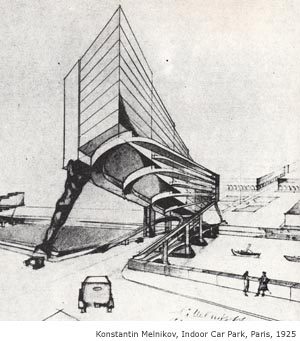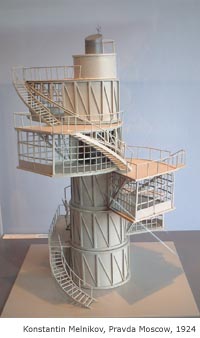Architecture, 1920-1930

It is ironic that the style of architecture dominating the capitalist
cities of the world owes much of their design influence to revolutionary
Russia. The dynamism and utopian ideals of the Russian socialist revolution
of 1917 were also evident in the arts through a movement known as 'Contructivism'.
It was an art movement, which included all the arts and focused on pure
geometric composition and strong dynamic lines.
Konstantin Melnikov born in 1890 was a Russian architect who broke with
the Classical tradition of architecture and pioneered revolutionary building
designs in the 1920's. These buildings still appear refreshingly modern
and contemporary today.
Melnikov's buildings appear to be in motion, spiraling upwards, stepping
out of themselves. They are dynamic designs of pure shapes and simplified
forms. His works often proposed bold structural process such as cantilevering
floors and walkways. He also proposed revolutionary sites for structures
such as a multi-level car park perched across a river, on a bridge in
Paris.
For this exhibition, design schools around Europe have recreated models
of many of Melnikov's buildings. They are displayed in a stunning 'contructivist'
backdrop of angled Perspex and revolutionary red walls. The exhibition
includes graphic documentary material as well as an excellent video on
the life of the architect.
In 1931, Melnikov proposed his 'Green City' concept for a Moscow district.
This was a utopian and theoretical plan for a better urban environment,
which was designed around the needs of people. His idea centered on the
need for quality rehabilitative sleep. Melnikov recognized that humans
spend almost a third of their life asleep and saw this time as restorative
-- almost miraculous and curative.
Melnikov's Green City was planned around a circle, which was divided into
six sectors of forest, collective farmlands, gardens, zoo and children's
sectors. Situated in the middle was the 'Institute of for the Transformation
of Humankind'. The rise of Stalin meant the fall of utopian reformers.
In design, the official preference was for traditional triumphant classical
forms.
In 1937, Melnikov was officially dismissed as an architect. His work from
a decade in the 1920's remains as one of the most creative and dynamic
in architectural history. It was not until 1972 when he was belatedly
recognized in his own country and awarded the title of 'Architect of Merit'.
Perhaps one of the great understatements of the 20 century.


